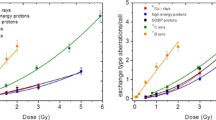Summary
Satellite associations were used as parameters to test nucleolar organizer activity. Assuming that toxic and/or mutagenic agents may affect the ribosomal genes, satellite associations in human lymphocytes were analysed following exposure to X-rays and compared with the satellite association pattern of subjects exposed to TCDD. A significant decrease in the satellite association frequency in D group chromosomes was found both in irradiated lymphocytes and in subjects exposed to Dioxin. The findings seem to be in accordance with the hypothesis based on random damage of functional nucleolar organizing regions.
Similar content being viewed by others
References
Cohen MM, Shaw MW (1967) The association of acrocentric chromosomes in 1000 normal human male metaphase cells. Ann Hum Genet 31:129–137
Curtis DJ (1974) Acrocentric associations in mongol populations. Hum Genet 22:17–22
Davison EV, Roberts DF, Callow MH (1981) Satellite association in Down's syndrome. Hum Genet 56:309–313
Di Lernia R (1980) Satellite association analysis of the human acrocentric chromosomes (1), (2). Atti Ass Genet It 26:127–133
Di Lernia R, Riva ML, Dalpra L, Ginelli E (1980) Satellite associations and silver staining in a case of multiple G and D variants. Hum Genet 53:237–240
Di Lernia R, Della Valle G, Tenchini ML, Tibaldi E (1981) Comparison between a specific rRNA inhibitor (MPB) and X-ray effects on satellite associations in human chromosomes. Mutat Res 85:253
Dittes H, Krone W, Bross K, Schmid M, Vogel W (1975) Biochemical and cytogenetic studies on the nucleolus organizing regions (NOR) of man. Hum Genet 26:47–59
Evans HJ, Bukland RA, Pardue ML (1974) Location of the genes coding for 18S and 28S ribosomal RNA in the human genome. Chromosoma 48:405–426
Henderson AS, Warburton D, Atwood KC (1973) Ribosomal DNA connectives between human acrocentric chromosomes. Nature 245:95–97
Houghton JA (1979) Relationship between satellite association and the occurrence of nondisjunction in man. Mutat Res 61:103–114
Houghton JA, Bedard MA (1981) A study of the role of nucleolus organizers and acrocentric chromosome associations in the causation of nondisjunction in man. In: Trisomy 21. Springer-Verlag, Berlin Heidelberg New York, p 243
Kirsch-Volders M, Hens L, Verschaeve L, Alexander A, Driesen M, Poma K, Susanne C (1978) Modification of human acrocentric associations after in vivo exposure to environmental mutagens. Acta Anthropogenetica 2:1–16
Krystal M, D'Eustachio P, Ruddle FH, Arnheim N (1981) Human nucleolus organizers on nonhomologous chromosomes can share the same ribosomal gene variants. Proc Natl Acad Sci USA 78: 5744–5748
Makino S (1975) In: Human chromosomes. Irradiation. Igaku Shoin Ltd Tokyo. North-Holland Publishing Company, Amsterdam Oxford, pp 392–395
Markovic VD, Worton RG, Berg JM (1978) Evidence for the inheritance of silver-stained nucleolus organizer regions. Hum Genet 41: 171–187
Mattei JF, Mattei MG, Ayme S, Giraud F (1974) Etude chromosomique chez les parents d'enfants trisomiques 21. Association entre chromosomes acrocentriques. Hum Genet 25:29–48
Mikelsaar AV, Schwarzacher HG, Schnedl W, Wagenbincher P (1977) Inheritance of Ag-stainability of nucleolus organizer regions investigations in 7 families with trisomy 21. Hum Genet 38:183–188
Miller OJ, Miller DA, Dev VG, Tantravahi R, Croce CH (1976) Expression of human and suppression of mouse nucleolus organizer activity in mouse-human somatic cell hybrids. Proc Natl Acad Sci USA 73:4531–4535
Miller DA, Tantravahi R, Dev VG, Miller OJ (1977) Frequency of satellite association is correlated with amount of Ag-staining of the nucleolus organizer region. Am J Hum Genet 29:490–502
Mottura A, Tenchini ML, Crimaudo C, De Carli L, Giorgi R, Nuzzo F, Zei G, Fraccaro M, Veneroni P, Nicoletti B, Paggini L, Simoni G, Dalprà L, Mocarelli P (1980) Cytogenetic investigations on the Seveso population exposed to TCDD. International Workshop on “Plans for clinical and epidemiologic follow-up area-wide chemical contamination”. Unpublished. Washington, March 17–19
Mottura A, Zei G, Nuzzo F, Crimaudo C, Giorgi R, Veneroni P, Paggini L, Mocarelli P, Fraccaro M, Nicoletti B, De Carli L (1981) Evaluation of results of chromosome analyses on lymphocytes of TCDD exposed subjects after the Seveso accident. Mutat Res 85: 238–239
Nie NH, Hull CH, Jenkins JG, Steinbrenner K, Bent DH (1975) Statistical package for the social sciences, 2nd edn. McGraw-Hill, New York Toronto
Piper WN, Rose JQ, Gehering PJ (1973) Excretion and tissue distribution of 2,3,7,8-tetrachlorodibenzo-p-dioxin in the rat. Environ Health Perspect 5:241–244
Preston RJ, Brewen JG (1978) X-ray-induced chromosome aberrations in the leucocytes of mouse and man. In: Evans HJ, Loyd L (eds) Mutagen-induced chromosome damage in man. Edinburgh University Press, Edinburgh, pp 33–40
Rose JQ, Ramsey JC, Wentzler TH, Hummel RA, Gehring PJ (1976) The rate of 2,3,7,8-tetrachlorodibenzo-p-dioxin following single and repeated oral doses to the rat. Toxicol Appl Pharmacol 36: 209–226
Stenstrand K (1977) Low dose X-radiation and acrocentric chromosome satellite associations in human leukocytes. Hereditas 88:131–133
Van Miller JP (1976) Tissue distribution and excretion of tritiated tetrachlorodibenzo-p-dioxin in nonhuman primates and rats. Food Cosmet Toxicol 14:31–34
Verschaeve L, Kirsch-Volders M, Hens L, Susanne C (1978) Chromosome distribution studies in phenyl mercury acetate exposed subjects and in age-related controls. Mutat Res 57:335–347
Verschaeve L, Driesen M, Kirsch-Volders M, Hens L, Susanne C (1979) Chromosome distribution studies after inorganic lead exposure. Hum Genet 49:147–158
Warburton D, Atwood RC, Henderson AS (1976) Variation in the number of genes for rRNA among human acrocentric chromosomes. Cytogenet Cell Genet 17:221–230
Wassom JS, Huff JE, Loprieno N (1977) A review of the genetic toxicology of chlorinated dibenzo-p-dioxin. Mutat Res 47:141–160
Zang KD, Back E (1968) Quantitative studies on the arrangements of human metaphase chromosomes. Individual features in the association pattern of the acrocentric chromosomes of normal males and females. Cytogenetics 7:455–470
Author information
Authors and Affiliations
Rights and permissions
About this article
Cite this article
Di Lernia, R., Crimaudo, C. & Pacchetti, G. The study of X-rays and TCDD effects on satellite associations may suggest a simple model for application in environmental mutagenesis. Hum Genet 61, 42–47 (1982). https://doi.org/10.1007/BF00291330
Received:
Revised:
Issue Date:
DOI: https://doi.org/10.1007/BF00291330




